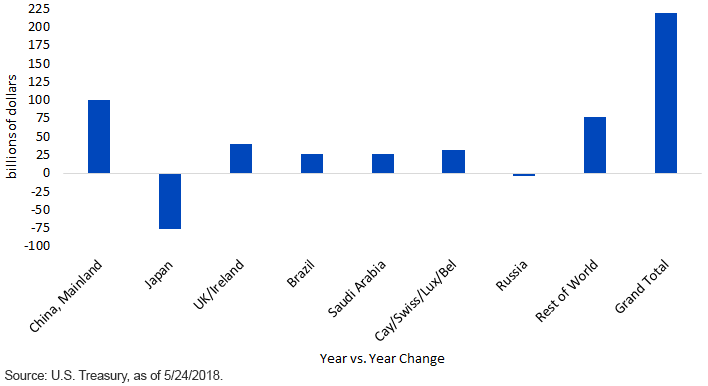U.S. Treasuries: Is Anybody Buying?


With the U.S. Treasury (UST) 10-Year note yield hitting its highest level since 2011 earlier this month, investors have been asking if any buyers have emerged. As of this writing, the answer would be yes, as the 10-Year yield actually dropped almost 20 basis points over the last week or so. However, this blog post is not going to focus on that most recent development. Instead, I want to turn your attention to a broader perspective, namely what has been the trend for foreign buying of Treasuries.
I have frequently mentioned that one of the key factors behind the UST market outlook is the prospect for rather sizeable increases in Treasury supply. This development has certainly been playing out, as the nation’s debt managers have already announced two separate increases in the amount of notes and bonds that will be auctioned this year, with the latest occurring as recently as May 2. Naturally, that begs the question: Will there be sufficient buyers to avoid a potential rise in yields, or will higher yields be needed to entice such buyers?
Major Foreign Holders of U.S. Treasuries - Mar 2018

Unfortunately, this burgeoning Treasury supply need is occurring against the backdrop of one less, big, important buyer. No, not China—the Federal Reserve (Fed)! As a reminder, the Fed commenced its balance sheet normalization plan back in October and, thus far, has continued right according to its previously announced script. As of this writing, the Fed’s System Open Market Account (SOMA) has seen a drop of $104.7 billion1 in total holdings. Of this amount, SOMA has witnessed a decline of $78.4 billion in Treasuries. Assuming the Fed maintains its course, this figure will only increase throughout 2018 and beyond, with the UST peak drawdown slated to be $90.0 billion per quarter.
Let’s get back to China. Contrary to popular belief, at least in the conversations I’ve had lately, China’s holdings of Treasuries have actually been on the rise. The accompanying table provides a clear illustration of this trend over the last 12 months. To provide some perspective, through March (the latest data available), China purchased nearly $100 billion in Treasuries.2 In fact, China’s purchases represented 46% of the overall annual increase in foreign holdings.3 How about two more additional fun facts? In March, China’s UST holdings rose to a five-month high, and for 2017 as a whole, they rose to the most they had in seven years.
Conclusion
Admittedly, China’s UST holdings as a percentage of total foreign holdings has fallen over the years. In July 2011, the peak reading hit 28% before falling to a low of 17.6% in February of last year. However, as I’ve outlined in this blog post, the trend has been reversing, and the level through the end of Q1 has risen back up to almost 19%.4 Although it would seem improbable for this percentage to increase to the previous peak reading anytime soon, in my opinion, fears of China liquidating its Treasury positions are equally unfounded.
1Source: Federal Reserve, as of 5/24/18.
2Source: U.S. Treasury, as of 5/24/18.
3Source: U.S. Treasury, as of 5/24/18.
4Source: U.S. Treasury, as of 5/24/18.


